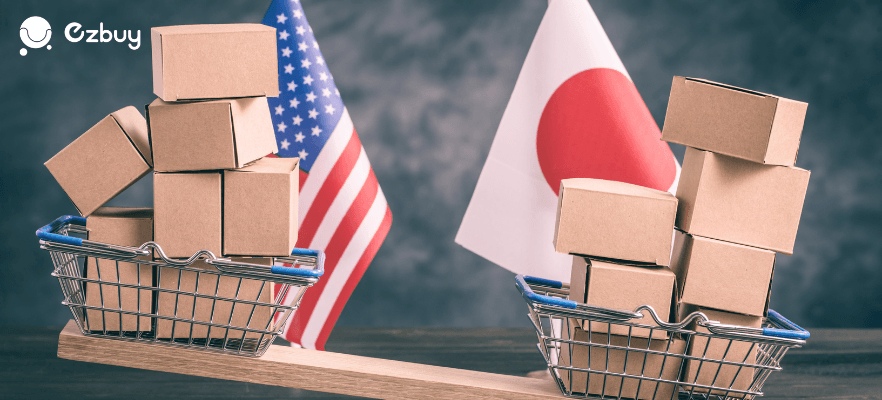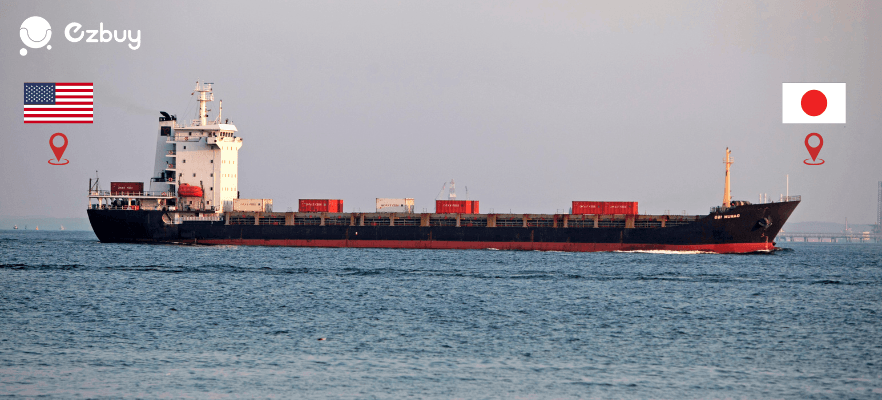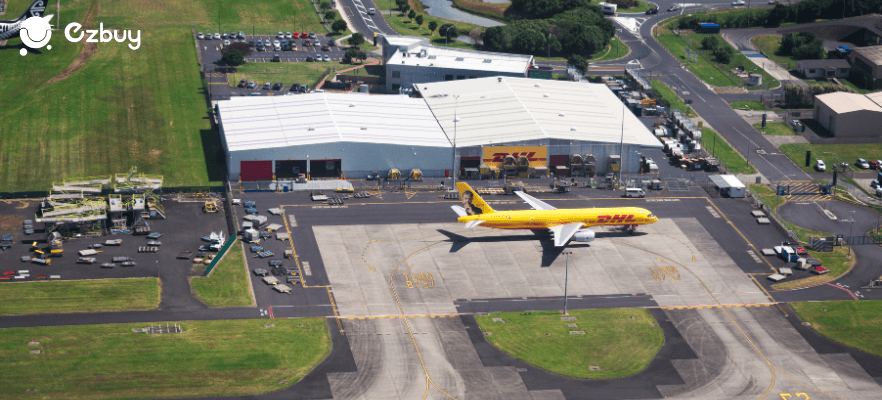Shipping from the US to Japan – Your 2025 Guide to Save Time and Money
By Macy -05/05/2025 UTC.
Shipping from America to Japan is becoming more and more popular with businesses and consumers alike. Whether you're sending personal gifts, online shopping, or commercial goods, having knowledge about logistics and global shipping will save you considerable time and money.
This blog is dedicated to taking you through all the most critical information on shipping from the US to Japan, from prices and time to optimal delivery practices these days.
1. How much is shipping from US to Japan?
The price you will have to pay for shipping from America to Japan will depend on a few underlying factors: package weight and size, how you ship, and with whom you ship. Understanding these variables can help you estimate your costs more accurately and select the best option for your needs.
1.1. Key Factors That Influence Shipping Costs
Shipping from USA to Japan cost consists of many factors, mostly depending on the package sizes and delivery time. When it comes to calculating this fee, you should take a look at some points below:
- Weight and size: Bigger and heavier parcels are most expensive to ship. The carrier bills by actual weight or dimensional weight (the higher of the two). Volume discount or package consolidation is offered by some carriers, freight forwarders primarily, if you ship often or in bulk. This is particularly handy for online buyers or merchants with simultaneous purchases from US retailers.
- Shipping speed: Express delivery is quicker and more expensive, while economy or basic services include slower delivery at a lower price.
- Carrier choice: Different carriers have different rates. For example, USPS may provide a better rate for smaller packets, while FedEx or DHL may provide a better price for priority or bulk shipments.
- Destination within Japan: Tokyo and Osaka are generally easier (and sometimes less expensive) to ship to, and rural locations can have added surcharges.
- Additional services: Tracking, insurance, or signature on delivery are services that may be added to the total charge.

1.2. Typical Shipping Cost Estimates
We have researched and summarized shipping from US to Japan cost estimates of common methods. Note that those are for standard size packages, around 2-10 lbs:
2. How long to ship from US to Japan?
Shipping a package from America to Japan is different depending on the method, carrier, and processing through customs. No matter if you are shipping an e-commerce order or a personal package, it will help you have realistic expectations about yourself and for your receivers about how long delivery will take.
Factors that can affect delivery time
- Customs clearance: The customs clearance process often goes within a day or two, and delivery companies calculate it into the general delivery time. There are a few cases that packages can not go through customs as they are missing or restricted, so the delivery time may be delayed for a period.
- Origin and destination points: Products from US coastal cities (e.g., Los Angeles or San Francisco) reach Japanese destinations ahead of those sent from non-coastal cities. Delivering to Japanese major cities like Tokyo or Osaka is also faster than delivery to rural areas in the country.
- Seasonality: There's a greater volume shipped in high-seasonal periods such as holiday shopping, shopping festivals, or year-end sale shopping, thus causing longer transit times.
- Weather or global disruptions: Unfavorable weather or unexpected occurrences such as typhoons, earthquakes, or global supply chain disruptions (e.g., port strikes or pandemics) may impact shipping schedules.
Estimated shipping time by method
Below is a general overview of the typical shipping time from US to Japan offered by major delivery options:
3. Cheapest ways to ship to Japan from US?
If you desire to minimize delivery costs when sending products from the US to Japan, there are several affordable alternatives you can make use of. The most ideal method is determined by the goods' size, weight, priority, and the type of products you're sending. Below are the most inexpensive methods and services commonly used:

USPS first-class package international service
If you need to send light packages (less than 4 lbs or 1.8 kg) like accessories or clothing, USPS first-class package international tends to be the most economical way. But it tends to come with the longer shipping time of about 10-20 business days, and the tracking may not always be real-time.
USPS Priority Mail International flat rate boxes
USPS international flat rate priority mail boxes are an economical solution to send heavy packages from the US to Japan at a guaranteed cost, regardless of destination or weight (up to the weight limit of the box).
It is a reliable choice with stable pricing, tracking, and coverage for loss or damage up to $200, so it's a great fit for mid-weight packages where dimensional weight would otherwise escalate the cost. While slower than express, at a normal time of 6 to 10 business days, the trade-off is worthwhile for cost-sensitive carriers.
Consolidated shipping services / Freight forwarders
The type of consolidated shipping services achieved by freight forwarders such as Ezbuy Japan, Shipito, or Stackry represents an intelligent approach to decreasing expenditures for international delivery by merging multiple purchases into one shipment. This technique works particularly well for people who buy from multiple US-only stores or bulk sellers, as it can lower costs by 30-60% in comparison to sending items separately.
Although there is a possibility of extra fees for handling, a longer processing time, and an increase in some fees, the benefits tend to be more favorable than the consolidation’s disadvantages, which is wonderful for anyone who wants to balance cost and ease.
Economy shipping with major carriers
Services such as FedEx International Economy, DHL e-commerce, and Packet Plus, in addition to UPS’s Worldwide Saver (especially when booked through discounted shipping portals), provide economy services for greater value and reliability for heavier or mid-sized parcels shipped from the US to Japan. While they are not as fast as express service, these options, combined with negotiated rate contracts or business accounts, offer better value and dependability.
With estimated costs ranging from $60 to $100+, they are well-suited for small businesses or frequent shippers seeking lower costs without compromising too much on service quality.
Use a shipping platform for discounted rates
Using a shipping platform like Pirate Ship, ShipStation, or Easyship is a smart way to get discounted overseas rates, as they can leverage bulk prices from big carriers. These platforms are most valuable for small companies or high-volume shippers, offering tools for streamlined label printing, tracking, and order management, all in one place. While some platforms may require account setup or subscriptions to unlock advanced features, the savings and efficiency they provide can significantly reduce your delivery costs and simplify your workflow.
4. Top Carriers for Shipping from the US to Japan
Choosing the right carrier is essential to ensure your package arrives in Japan safely, quickly, and within budget. Several reputable international carriers offer reliable service between the US and Japan, each with its own strengths in speed, cost, and value-added features. Below is an overview of the top delivery providers to consider:

4.1. USPS (United States Postal Service)
Individuals and especially small businesses tend to favor USPS (United States Postal Service) for international shipping from US to Japan. This is because it offers a multitude of options, such as First-Class Package International for lighter packages, Priority Mail International, which allows for fast-tracked shipments, and the fastest USPS option - Priority Mail Express International, geared for urgent shipments.
Even shippers on a non-business level will find USPS useful due to its service in over 190 countries. Their reliable service at a relatively lower cost makes it an attractive starting point for new and low-volume shippers.
4.2. FedEx
FedEx’s extensive coverage in Japan, combined with its huge network all over the globe, enables the timely and safe delivery of shipments. The company has two major services for this country, and both differ in speed and price. FedEx International Economy is the slower option with 4-6 business days for delivery, but cheaper compared to FedEx International Priority, which delivers in 1-3 business days.
One of the best advantages of using FedEx is its consistently fast delivery rates. This makes them perfect for meeting urgent business deadlines, emergency shipments, or other time-sensitive tasks.
4.3. DHL Express
Through DHL Express Worldwide service, the deliveries are generally received in 1 - 4 business days, one of the quickest cross-border shipping services in the market. DHL's high reputation is built on its global coverage, speed of operations, and commitment to a high level of service.
DHL is well-suited to high-value or time-sensitive shipment applications, where speed and reliability are most important. Its comprehensive tracking system and excellent customer support also give extra confidence to senders who must meet stringent delivery deadlines.
4.4. UPS
UPS offers two main types of delivery: UPS Worldwide Expedited, which delivers in 2 to 5 business days, and UPS Worldwide Saver, a faster option that typically delivers within 1 to 3 business days.
With the detailed tracking the carrier provides from the point of origin to the ultimate destination, both the shippers and the recipient have complete visibility during the delivery cycle. Moreover, UPS’s integration with e-commerce and inventory systems is a major advantage for corporations managing operations in bulk. It enables businesses to maintain consistent delivery schedules for clients, increasing popularity among businesses.
4.5. Freight forwarders and consolidators
Freight forwarders and consolidators, such as Ezbuy Japan, Shipito, and Stackry, offer an easy and economical way to send numerous packages or bulk orders from the US to Japan. This significantly reduces the overall shipping expense, especially for international shoppers and businesses that shop from multiple US retailers.
By package consolidation and volume discount use, these forwarders are able to offer price usually 30 - 60% less than standard alternatives. Many forwarders also offer auxiliary services like repackaging, stripping of invoices, and preparing customs documents.
5. Expert Tips to Optimize Shipping from the US to Japan
Whether you're a personal shopper, a small business, or a giant retailer, simplifying the delivery process can save you time, lower costs, and improve customer satisfaction. Here are some tips from experts to simplify shipping from the US to Japan.
Consolidate multiple packages into one shipment
Rather than paying separate fees for each parcel, consolidation services allow you to consolidate all your items into one box, which can save you a great deal of money on delivery, especially when dimensional weight pricing is applied. This method is particularly helpful for online shoppers and e-commerce sellers who shop from different US-based stores or websites.
Firms like Ezbuy Japan have turned package consolidation into a business and offer value-added services such as professional repackaging, removal of unnecessary packaging, and even invoice removal for resale or gift purposes. Not only do these services reduce weight and volume, but they also simplify customs documentation and make shipping easier.
Choose the right shipping method for each order
Not all packages need to be express delivered - economy choices like USPS First-Class International or FedEx International Economy can deliver considerable savings for less critical shipments. Express couriers should be reserved for time-sensitive or high-value items, where speed and reliability justify the higher cost.
For B2C fulfillment, it's important to strike a balance between delivery speed and cost-efficiency, aligning your shipping strategy with your customers’ expectations and the nature of the products being shipped.
Be smart about package size and weight
To avoid additional fees, you must use appropriately sized boxes and avoid any redundant space that would increase volume and add weight. Minimalistic product packaging coupled with the use of padding reduces volume and weight. Freight forwarders have repacking services, where your items are packed into boxes at the pre-shipment stage. This maximizes the box size and configuration, lowering delivery costs.
Plan ahead for peak seasons and delays
Increased sales peaks are accompanied by lengthened transit periods, increased operational lag, limited availability of the carrier, and higher base fees or added fees. To make sure that there are no delays, shipping well in advance, along with using verified services that allow constant monitoring of your shipment, is one way of minimizing last-minute rush complications.
Use a fulfillment partner for e-commerce sales
If you intend on selling in Japan, having a partner like Ezbuy Japan enables the streamlining of your e-commerce operations. Quick and inexpensive domestic delivery is made possible through strategically located inventory, which prevents constant international shipments.
This not only results in better and faster deliveries, but also improves overall value for consumers, which is ideal for sellers who want to penetrate the Japanese market fast.
>>> Read more: Fast and accurate order shipping for your online business in Japan
6. FAQs
- What items are prohibited when shipping from US to Japan?
When sending a parcel from the US to Japan, keep in mind all restricted and prohibited items to avoid any problems with customs.
It is always safer to confirm with your courier service company and customs authority before shipping anything that may come under the restricted category. Each item could have certain restrictions, including a particular checklist, and might be permitted with the correct paperwork.
More information about prohibited items regarding US-Japan shipping can be viewed in this list.
- Do I have to pay duties and taxes when shopping from the US and shipping to Japan?
Yes, you do. Charges are set by Japan Customs and are usually relevant to the declared amount, type, and value of the goods.
Always examine the item’s import classification to ensure there will be no unexpected issues and cross-verify with your logistics partner or fulfillment center if there is going to be an additional charge to the shipment.
- What is the most cost-effective way to ship to Japan?
The most economical approach to shipping to Japan from US depends on the shipment’s size, weight, urgency, and whether a person or a business is making the shipment. As a summary, USPS First-Class Package International is the best for individuals or businesses with small, lightweight items under 4 lbs, and for medium-weight packages that can fit into flat-rate boxes, USPS Priority Mail International Flat Rate is the most economical. Lastly, for bulk orders, multi-store orders, or mount orders, using freight forwarders is most suitable.
7. Conclusion
Shipping from the US to Japan should not be an ordeal or expensive, especially if you have your options in mind and take a strategic approach. Being a private consumer, a casual online shopper, or a growing business, you have options there that fit your needs, including affordable postal providers to premium express couriers and freight forwarders like Ezbuy Japan.
By choosing the right carrier, consolidating shipments, and strategizing on timing and packaging, you can save significantly while maintaining delivery smoothness. With appropriate tools and coordination, sending goods to Japan is quicker, easier, and more convenient than ever.
Website: https://ezbuy.jp/en
Email: [email protected]